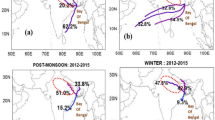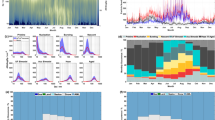Abstract
The total extent of the atmospheric impacts associated to the aerosol black carbon (BC) emissions from South America is not completed described. This work presents results of BC monitored during three scientific expeditions (2002, 2003 and 2004) on board of a Brazilian oceanographic vessel Ary Rongel that covered the South–West Atlantic coast between 22–62°S. This latitudinal band encloses major urban regions of South America and the outflow region of the SACZ (South Atlantic Convergent Zone), which is an important mechanism of advective transport of heat, moisture, minor gases and aerosols from the South America continental land to the Southern Atlantic Ocean. Our results showed that aerosol BC enhanced concentrations from urban/industrial origin can be transported to the South–West Atlantic Ocean due to the migration of sub-polar fronts that frequently reach tropical/subtropical regions. Despite the decrease of aerosol BC concentrations southwards (from ∼1,200 ng m−3 at latitude 22°S to ∼10 ng m−3 at latitude 62°S), several observed peak events were attributed to regional urban activities. Most of such events could be explained by the use of air mass back trajectories analysis. In addition, a global model simulation is presented (Goddard Institute for Space Studies – GISS GCM BC simulation) to explore the origins of aerosol BC in the South–West Atlantic. The model allowed isolating the biomass emissions from South America and Africa and industrial (non-biomass) pollution from other regions of the globe. This model suggests that the apportionment of about half of the aerosol BC at the South–West Atlantic may derive from South American biomass burning.








Similar content being viewed by others
References
Bond, T.C., Streets, D.G., Yarber, K.F., Nelson, S.M., Woo, J., Klimont, Z.: A technology-based global inventory of black and organic carbon emissions from combustion. J. Geophys. Res. 109, D14203 (2004), doi:10.1029/JD003697, (2003)
Castanho, A.D.A., Artaxo, P.: Wintertime and summertime São Paulo aerosol apportionment study. Atmos. Environ. 35, 4889–4902 (2001)
Chen, L.W.A., Doddridge, B.G., Dickerson, R.R.: Observation of carbonaceous aerosols and carbon monoxide at a suburban site: Implication for an emission inventory. International Emission Inventory Conference, “One Atmosphere, One Inventory, Many Challenges.” Denver, CO, April 30 (2001)
Evangelista, H.: Emprego do Radônio na caracterização de Fenômenos de Transporte e Impacto Ambiental atmosféricos na Ilha Rei George (Antártica). Tese de Doutorado UERJ, Rio de Janeiro, (1998)
Freitas, S.R., Longo, K.M., Dias, M.A.F.S., Artaxo, P.: Numerical modeling of air mass trajectories from the biomass burning areas of the Amazon basin. An. Acad. Bras. Ciênc. (Regional Conference on Global Change) 68, 193–206 (1996)
Hansen, D.A., Schnell, R.C.: The Aethalometer. Magge Scientific Company, Berkeley, CA (1991)
IPCC: Report of working group I of the intergovernmental panel on climate change, summary for policymakers (2001)
Kaufman, Y.J., Hobbs, P.V., Artaxo, P., Remer, L.A., Holben, B.N., King, M.D., Ward, D.E., Prins, E.M., Longo, K.M., Mattos, L.F., Nobre, C.A., Spinhirne, J.D., Ji, Q., Thompson, A.M., Gleason, J.F., Christopher, S.A., Tsay, S.-C.: Smoke, clouds, and radiation – Brazil (SCAR-B) experiment. J. Geophys. Res. 103(D24), 31783–31808 (1998)
Koch, D., Hansen, J.: Distant origins of Arctic Black Carbon: A GISS ModelE experiment, J. Geophys. Res. 110(D04204), (2005), doi:10.1029/JD005296, 2005
Koch, D., Schmidt, G.A., Field, C.: Sulfur, sea-salt and radionuclide aerosols in GISS modelE. J. Geophys. Res. 111(D06206), (2006)
Koch, D., Streets, D., Bond, T., Hansen, J., Bell, N., van der Werf, G.: Regional and sectoral attributions of present-day aerosols, submitted to J. Geophys. Res. in press (2006)
Liousse, C., Cachier, H., Jennings, S.G.: Optical and thermal measurements of black carbon aerosol content in different environments: Variation of the specific attenuation cross-section, sigma (σ). Atmos. Environ. 27, 1203–1211 (1993)
Menon, S., Hansen, J., Nazarenko, L., Luo, Y.: Climate effects of black carbon in China and India. Science 297, 2250–2253 (2002)
Nobre, C.A., Mattos, L.F., Dereczynski, C.P., Tarasova, T.A., Trosnikov, I.: Overview of atmospheric conditions during the Smoke, Clouds and Radiation-Brazil (SCAR-B) field experiment. J. Geophys. Res. 103(D24), 31809–31820 (1998), December 27
Penner, J.E., Eddleman, H., Novakov, T.: Towards the development of a global inventory for carbono elementar emissions. Atmos. Environ. 27A, 1277–1295 (1993)
Pereira, E.B., Evangelista, H., Pereira, K.C.D., Cavalcanti, I.F.A., Setzer, A.W.: Apportionment of black carbon in the South Shetland Islands, Antarctic Peninsula. J. Geophys. Res. 111 (2006), DO3303. doi:10.1029/2005JD006086
van der Werf, G.R., Randerson, J.T., Collatz, G.J., Giglio, L.: Carbon emissions from fires in tropical and subtropical ecosystems. Glob. Chang. Biol. 9, 547–562 (2003)
van der Werf, G.R., Randerson, J.T., Collatz, G.J., Giglio, L., Kasibhatla, P.S., Arellano, A.F., Olsen, S.C., Kasischke, E.S.: Continental-scale partitioning of fire emissions during the 1997 to 2001 El Nino/La Nina period. Science 303, 73–76 (2004)
Wang, C.: A modeling study on the climate impacts of black carbon aerosols. J. Geophys. Res. 109 (2004), DO3 106. doi:10.1029/2003JD004084
Wolff, W.E., Cachier, H.: Concentration and seasonal cycle of black carbon in at a coastal Antarctic Station. J Geophys. Res. 103, D9, 11033–11041 (1998)
Acknowledgments
This work was supported by the Brazilian Antarctic Program (PROANTAR-CNPq)/MMA grant (Project 55.0353/2002-0: Ice-atmosphere relationship). We kindly thank to the Ary Rongel Oceanographyc Ship staff for technical support during the north–south expeditions to Antarctica. The authors gratefully acknowledge the NOAA Air Resources Laboratory (ARL) for the provision of the HYSPLIT transport and dispersion model and/or READY website (http://www.arl.noaa.gov/ready.html) used in this publication; and Mr. Heber R. Passos from INPE/CPTEC for the control wind system to avoid sampling of the ship's smoke.
Author information
Authors and Affiliations
Corresponding author
Rights and permissions
About this article
Cite this article
Evangelista, H., Maldonado, J., Godoi, R.H.M. et al. Sources and Transport of Urban and Biomass Burning Aerosol Black Carbon at the South–West Atlantic Coast. J Atmos Chem 56, 225–238 (2007). https://doi.org/10.1007/s10874-006-9052-8
Received:
Accepted:
Published:
Issue Date:
DOI: https://doi.org/10.1007/s10874-006-9052-8




